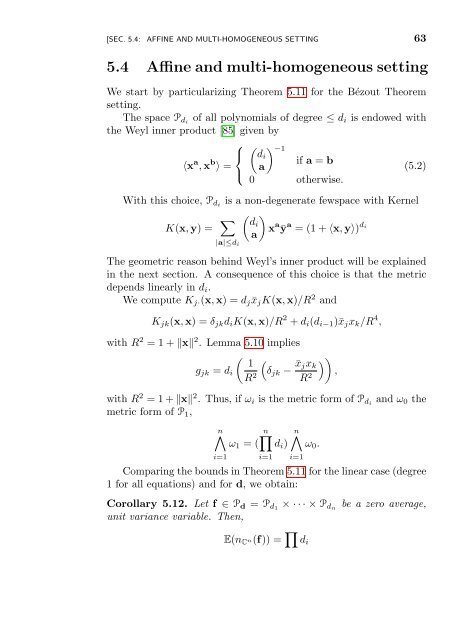Nonlinear Equations - UFRJ
Nonlinear Equations - UFRJ
Nonlinear Equations - UFRJ
You also want an ePaper? Increase the reach of your titles
YUMPU automatically turns print PDFs into web optimized ePapers that Google loves.
[SEC. 5.4: AFFINE AND MULTI-HOMOGENEOUS SETTING 63<br />
5.4 Affine and multi-homogeneous setting<br />
We start by particularizing Theorem 5.11 for the Bézout Theorem<br />
setting.<br />
The space P di of all polynomials of degree ≤ d i is endowed with<br />
the Weyl inner product [85] given by<br />
⎧ ( ) −1<br />
⎨ di<br />
〈x a , x b 〉 =<br />
if a = b<br />
a<br />
(5.2)<br />
⎩<br />
0 otherwise.<br />
With this choice, P di is a non-degenerate fewspace with Kernel<br />
K(x, y) = ∑ )<br />
x a ȳ a = (1 + 〈x, y〉) di<br />
a<br />
|a|≤d i<br />
(<br />
di<br />
The geometric reason behind Weyl’s inner product will be explained<br />
in the next section. A consequence of this choice is that the metric<br />
depends linearly in d i .<br />
We compute K j·(x, x) = d j ¯x j K(x, x)/R 2 and<br />
K jk (x, x) = δ jk d i K(x, x)/R 2 + d i (d i−1 )¯x j x k /R 4 ,<br />
with R 2 = 1 + ‖x‖ 2 . Lemma 5.10 implies<br />
g jk = d i<br />
( 1<br />
R 2 (<br />
δ jk − ¯x jx k<br />
R 2 ) ) ,<br />
with R 2 = 1 + ‖x‖ 2 . Thus, if ω i is the metric form of P di<br />
metric form of P 1 ,<br />
and ω 0 the<br />
n∧ n∏ n∧<br />
ω 1 = ( d i ) ω 0 .<br />
i=1<br />
i=1<br />
Comparing the bounds in Theorem 5.11 for the linear case (degree<br />
1 for all equations) and for d, we obtain:<br />
Corollary 5.12. Let f ∈ P d = P d1 × · · · × P dn be a zero average,<br />
unit variance variable. Then,<br />
i=1<br />
E(n C n(f)) = ∏ d i

















